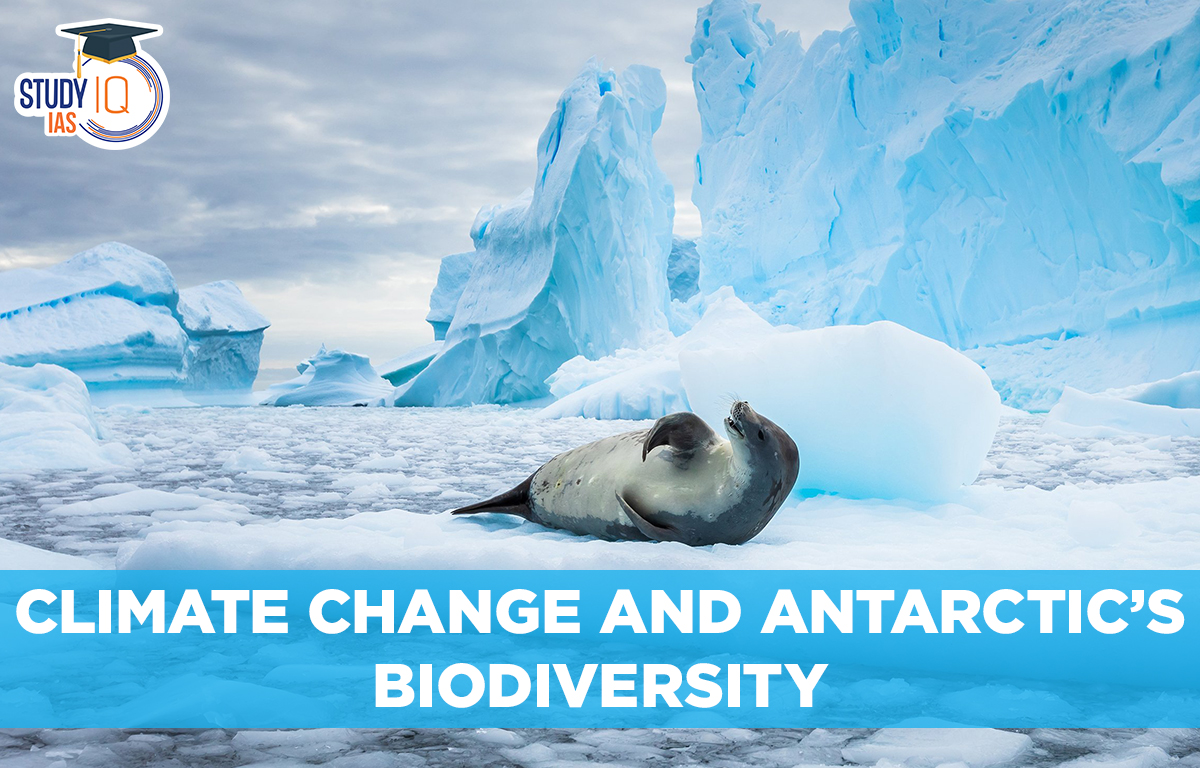Table of Contents
Context: A new study has found that if necessary conservation efforts are not taken, up to 97 percent of land-based Antarctic species could decline by the end of this century due to climate change.
Declining Antarctic Biodiversity
- Terrestrial species: The populations of 97% of Antarctic terrestrial species and breeding seabirds could decline between now and 2100, if current conservation efforts stay on the same trajectory.
- Emperor penguin: The emperor penguin relies on ice for breeding, and is the most vulnerable of Antarctica’s species, is at risk of extinction by 2100.
- Other specialist species: Climate change will also likely wreak havoc on other Antarctic specialists, such as the nematode worm Scottnema lindsayae. These species lives in extremely dry soils, and is at risk as warming and ice-melt increases soil moisture.
Impacts of Climate Change on Antarctica’s Biodiversity
- Habitat loss: As global warming worsens, Antarctica’s ice-free areas are predicted to expand, rapidly changing the habitat available for wildlife.
- Extreme events: As extreme weather events such as heatwaves become more frequent, Antarctica’s plants and animals are expected to suffer.
- Invasive species: Increasing tourism and research activities, and milder temperatures in Antarctica due to global warming also creates the conditions for invasive species to thrive.
- Colonization by plants: Melting of perennial snow and ice covers has resulted in increased colonization by plants. According to a study, The increase in plants since 2009 has been greater than the previous 50 years combined
- Pollution from Permafrost: Increasing temperatures in Antarctica also leads to melting of permafrost which can release many chemicals contaminants and nutrients, which in turn affects the water chemistry and wildlife in the region.
- Beneficiary species: Climate change won’t lead to a decline in all Antarctic species – in fact, some may benefit initially. These include two Antarctic plants, some mosses and the Gentoo penguin.
- These species may increase their populations and become more widely distributed in the event of more liquid water (as opposed to ice), more ice-free land and warmer temperatures.
Way Forward
- Climate change mitigation: Reducing climate change to no more than 2 degrees Celsius of warming would benefit up to 68% of terrestrial species and breeding seabirds.
- Regional and global efforts: As Antarctica faces increasing pressure from climate change and human activities, a combination of regional and global conservation efforts is needed.
- Species protection: Measures such as granting special protections to species, and increasing bio-security to prevent introductions of non-native species should be adopted.
- Funding: Spending just USD 23 million a year to preserve Antarctica’s biodiversity and ecosystems is an absolute bargain.
About Antarctica
- Antarctica is Earth’s southernmost and the fifth-largest continent.
- It is mainly a polar desert and is covered mostly by the Antarctic ice sheet, with an average thickness of 1.9 km.
- About 70% of the world’s freshwater reserves are frozen in Antarctica, which, if melted, would raise global sea levels by almost 60 metres.
- Biodiversity: Native species of animals include mites, nematodes, penguins, seals and tardigrades. Where vegetation occurs, it is mostly in the form of lichen or moss.

- Significance of Antarctica:
- Global climate regulation: It helps regulate the global climate by driving atmospheric circulation and ocean currents, and absorbing heat and carbon dioxide.
- Limiting Global Warming: Antarctic ice deflects some of the sun’s rays away from the Earth, keeping temperatures tolerable.
- Climate indicator: The discovery of an ozone hole over Antarctica in 1985 revealed the damage man-made chemicals are doing to the Earth’s atmosphere.
- Sea level rise: Complete melting of the massive Antarctic ice sheet is projected to be unlikely, but even a small melt could raise global sea levels and cause flooding around the world.
- Antarctic Treaty System: There are few related agreements that make up the Antarctic treaty system. They are as follows:
- The Protocol on Environmental Protection to the Antarctic Treaty (Madrid, 1991)
- The Convention for the Conservation of Antarctic Seals (CCAS, London, 1972)
- The Convention on the Conservation of Antarctic Marine Living Resources (CCAMLR, Canberra, 1980).
- India and Antarctica:
- India is expanding its infrastructure development in Antarctica.
- The newest base commissioned in 2015 is Bharati.
- India is rebuilding its second station, Maitri, to make it bigger and last for at least 30 more years.
- Dakshin Gangotri, the first Indian base established in 1984, has weakened and become just a supply base.


 Serious Fraud Investigation Office (SFIO...
Serious Fraud Investigation Office (SFIO...
 Article 142 of Indian Constitution, Sign...
Article 142 of Indian Constitution, Sign...
 Pakistan-Occupied Kashmir (PoK): History...
Pakistan-Occupied Kashmir (PoK): History...





















